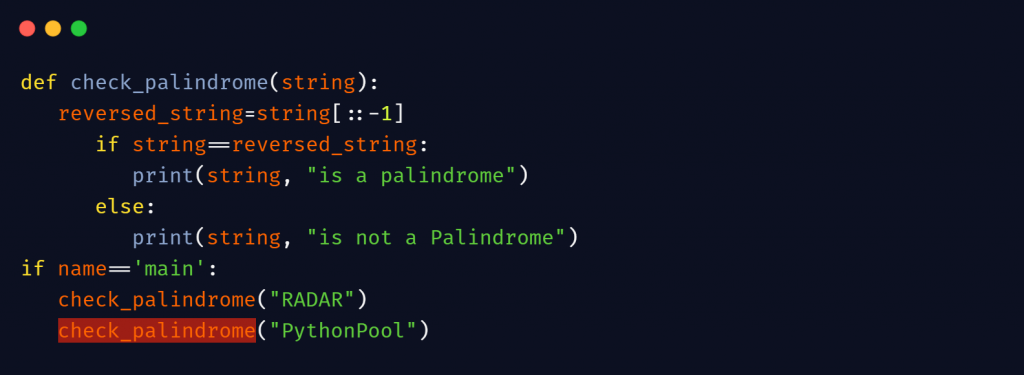One of the most basic and commonly asked interview questions is to check whether a string is a palindrome or not using python. A palindrome is a string or a number that, if we reverse, equals the original value. For example- if we reverse the string MALAYALAM, we will get back the original string. Also, if we reverse the number 12321, we will get 12321 back. These are known as palindromes.
In this article, we will learn how to check whether a string or a number is a palindrome or not in many different ways. In addition to it, we will solve some fun questions which are commonly asked in competitions and interviews.
Checking Whether a String is a Palindrome in Python
- Check Palindrome Using Slicing in Python
- Check Palindrome Using reversed() Function In Python
- Check Palindrome Using Using While Loop In Python
- Checking Whether a Number is a Palindrome in Python Using Loop
- Checking Whether a Phrase is a Palindrome in Python
- To find the Palindromic longest substring in a string
1. Check Palindrome Using Slicing in Python
We can use the concept of slicing to reverse the string, and then we can check whether the reverses string is equal to the original string or not.
def check_palindrome(string):
# transversing the string from last to first
reversed_string=string[::-1]
if string==reversed_string:
print(string, "is a palindrome")
else:
print(string, "is not a Palindrome")
if name=='main':
check_palindrome("RADAR")
check_palindrome("PythonPool")
Output- RADAR is a palindrome PythonPool is not a Palindrome

The above method is straightforward to use and also a good method, and you can use it in competitions, but people generally don’t prefer to use it in interviews. This method is so simple, and people prefer to code from scratch to make this kind of program to show their skills. We will study that approach too in the following section.
2. Check Palindrome Using Loop In Python
def is_palindrome(string):
reversed_string=""
# transversing through string from last
for i in range(len(string),0,-1):
# Addind last characters of string into a new string
reversed_string+=string[i-1]
if string==reversed_string:
print("Palindrome")
else:
print("Not a palindrome")
if __name__==__'main'__:
is_palindrome("racecar")
is_palindrome("Python")
Output- Palindrome Not a palindrome
3. Check Palindrome Using reversed() Function In Python
string="MALAYALAM"
# joining characters of reversed string one by one
reversed_string = ''.join(reversed(string))
if reversed_string==string:
print(string," is Palindrome")
else:
print(string,"Not a Palindrome")
Output- MALAYALAM is Palindrome
4. Check Palindrome Using Using While Loop In Python
<pre class="wp-block-syntaxhighlighter-code">def check_palindrome(string):
l= len(string)
first = 0
last = l-1
isPalindrome=True
# ensuring that we do not <a href="https://www.pythonpool.com/python-iterate-through-list/" target="_blank" rel="noreferrer noopener">iterate</a> through more than half # of the list
while(first<last):
# if the first character is same as last character keep # moving further
if(string[first]==string[last]):
first=first+1
last=last-1
# if the characters at first and last do not match break # the loop
else:
isPalindrome=False
break
return isPalindrome
string="MADAM"
isPalindrome=check_palindrome(string)
if(isPalindrome):
print("It is a palindrome ")
else:
print("Not a Palindrome")</pre>
Output- It is a palindrome
5. Checking Whether a Number is a Palindrome in Python Using Loop
We are going to use the following concept-
Number=12321
The remainder of this number, when divided by 10, is:
Number%10=12321%10=1
Reverse_Number=Remainder=1
Then, we will divide the number by 10.
Number=Number/10=12321//10=1232
Remainder=1232%10=2
Reverse_Number=Remainder=12
Number= 1232/10=123
Remainder=123%10=3
Reverse_Number=Remainder=123
Number= 123/10=12
Remainder=12%10=2
Reverse_Number=Remainder=1232
Number= 12/10=1
Remainder=1%10=1
Reverse_Number=Remainder=12321
Program-
number=12321
reverse_number=0
n=number
# while we have not reached the end of the number
while(n !=0):
# finding the last element of number 'n'
rem = n % 10
reverse_number = reverse_number * 10 + rem
n=int(n / 10)
if(number == reverse_number):
print("Palindrome")
else:
print("Not a Palindrome")
Output- Palindrome
We can also first convert the number into a string and then apply any of the methods above to check if the number is palindrome or not.
number=12321
# converting the number to string and then reversing it
if str(number)[::-1]==str(number):
print("Number:",number," is a Palindrome")
else:
print("Number:",number," is not a Palindrome")
Output- Number: 12321 is a Palindrome
6. Checking Whether a Phrase is a Palindrome in Python
Checking if a phrase is a palindrome or not is different from checking if a word is a palindrome or not. So, we cannot apply any of the above methods for a phrase.
For example- The phrase ‘Too hot to hoot’ is a palindrome if you ignore the upper case – lower case and spaces in the characters.
def is_palindrome(string):
reversed_string=""
# Removing all the spaces
s=string.replace(" ","")
# making the whole string in lowercase characters
s=s.lower()
for i in range(len(s),0,-1):
if s[i-1] >='a' and s[i-1]<='z':
reversed_string+=s[i-1]
if s==reversed_string:
print("Palindrome")
else:
print("Not a palindrome")
if __name__=='__main__':
is_palindrome("Too hot to hoot")
is_palindrome("Python")
Output- Palindrome Not a palindrome
There are some other types of palindromes, like- ‘Is it crazy how saying sentences backward creates backward sentences saying how crazy it is.’ It is different from other palindromes we have discussed until now because here, if we reverse the characters, it is not a palindrome. But if we reverse it word by word, it is a palindrome.
Program-
string='Is it crazy how saying sentences backwards creates backwards sentences saying how crazy it is'
string1=string.lower()
string1=string.replace(" ","")
new_string=""
# Wherever there is any space make a list element
list1=string1.split(" ")
# join the list into string starting from the last
reverse="".join(list1[::-1])
reverse_string=""
for i in reverse:
# adding only characters in the new string
if i>='a' and i<='z':
reverse_string+=i
for i in string1:
if i>='a' and i<='z':
new_string+=i
if new_string==reverse_string:
print(string,":Palindrome")
else:
print(string,":Not a Palindrome")
Output- Is it crazy how saying sentences backward creates backward sentences saying how crazy it is: Palindrome
7. To find the Palindromic longest substring in a string
A very common and interesting question on palindromes is to find the longest substring, which is a palindrome from a string that may or may not be a palindrome. I suggest you try it yourself once and then look at the solution below.
There are many ways to solve this problem. We will go for the easiest one which all of us will be able to understand easily.
m=""
s='babad'
for i in range(len(s)):
# iterating through the string from the last
for j in range(len(s),i,-1):
# ensuring that we do not iterate through more than half of
# the string
if len(m)>=j-i:
break
elif s[i:j]==s[i:j][::-1]:
m=s[i:j]
print(m)
Output- bab
The time complexity for the above program is O(n^2) as we have a for loop inside a for a loop.
Must Read
- How to Convert String to Lowercase in
- How to Calculate Square Root
- User Input | Input () Function | Keyboard Input
- Best Book to Learn Python
Conclusion
We have studied what a palindrome is, how to check whether a string or a number is a palindrome. We have also covered some common interview questions like checking for a phrase if it is a palindrome and finding the longest substring, which is a palindrome in python. I hope you will try each problem, and please comment down if you face any issues in it.
